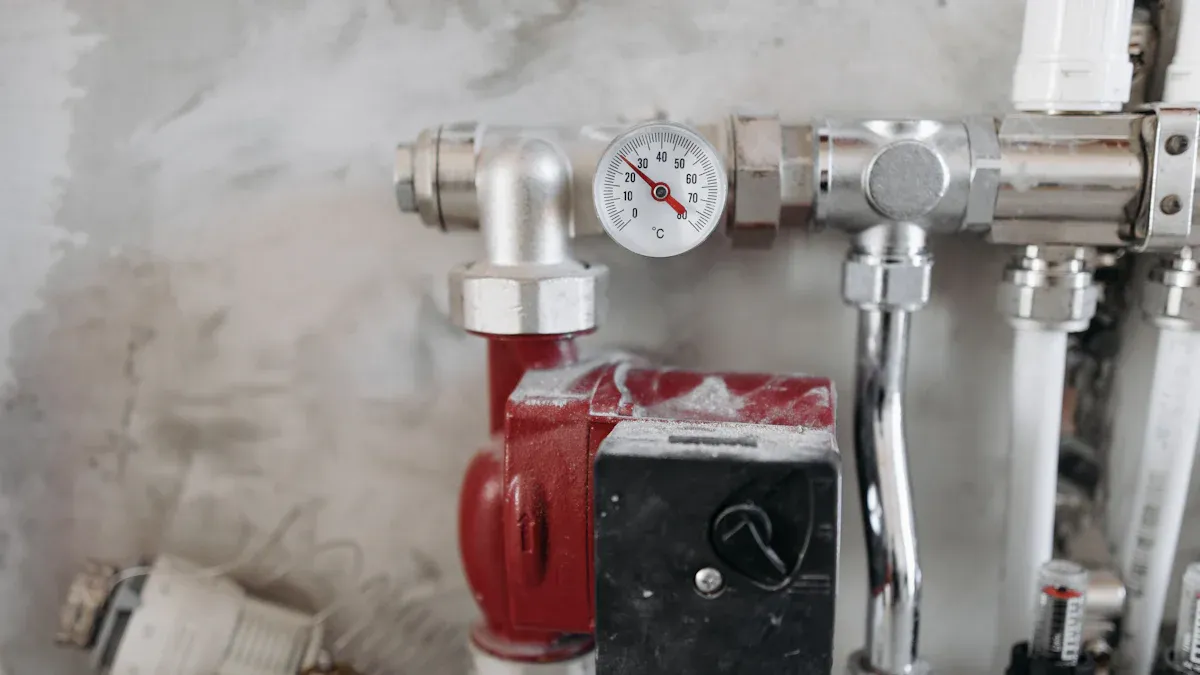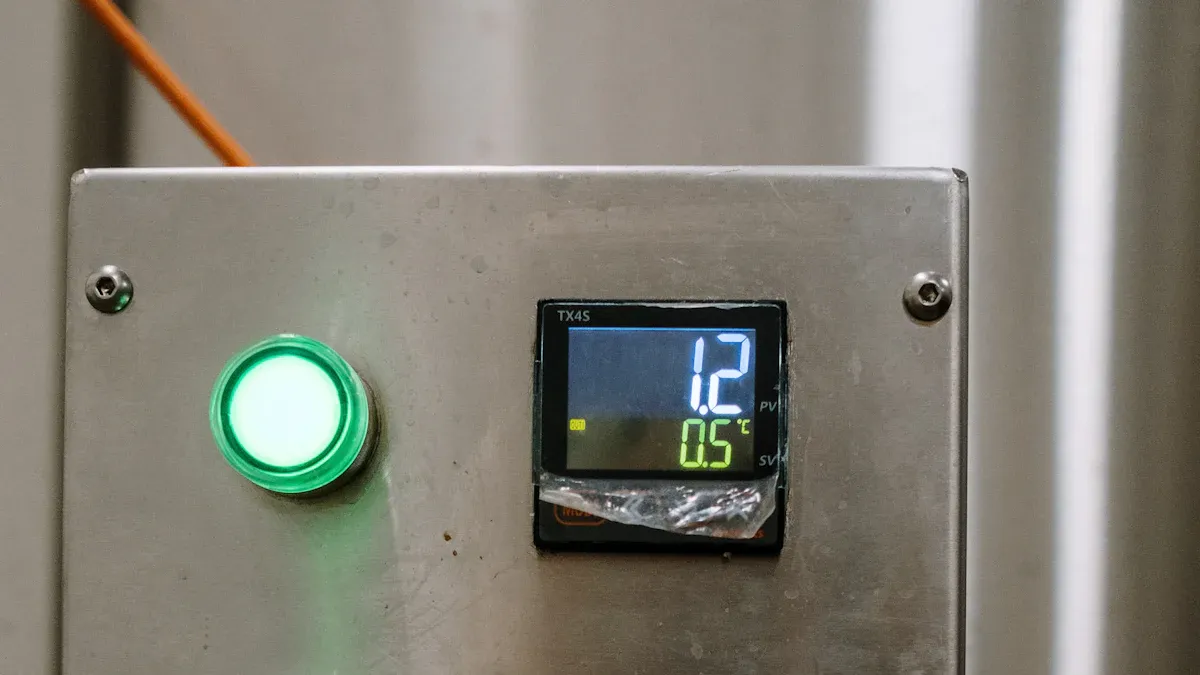
Process temperature control systems revolutionize Korean automotive production by ensuring precision and consistency. These systems optimize manufacturing processes, reducing errors and enhancing operational efficiency. They also maintain strict temperature parameters, which guarantees superior product quality. By fostering innovation, they empower manufacturers to adopt cutting-edge technologies, securing Korea’s leadership in the global automotive industry.
Key Takeaways
- Temperature control systems help make car parts with accuracy, lowering mistakes and improving quality.
- They make work faster by cutting delays and saving energy, which reduces costs.
- Using new tech like IoT with these systems makes factories smarter, more reliable, and flexible.
Overview of Process Temperature Control Systems
Definition and Importance
A process temperature control system is a specialized technology designed to regulate and maintain precise temperature conditions during manufacturing. These systems are essential in industries where temperature fluctuations can compromise product quality or operational efficiency. In automotive manufacturing, they ensure that critical processes, such as heat treatment and material curing, occur under optimal conditions. This precision minimizes defects and enhances the durability of automotive components.
Temperature regulation plays a pivotal role in improving safety and reducing costs. For instance, companies like Boeing and Ford have demonstrated how effective temperature control can enhance product quality and streamline operations. The following table highlights some industry examples:
| Industry Example | Benefits |
|---|---|
| Boeing | Enhanced product quality and reduced costs |
| Ford | Improved material properties and efficiency |
| Siemens | Increased safety and reduced downtime |
By maintaining strict temperature parameters, these systems contribute to cost savings, employee safety, and overall operational excellence.
Role in Automotive Manufacturing
Process temperature control systems are integral to automotive production. They optimize heating and cooling during heat treatment processes, which strengthens materials for high-performance applications. For example, advanced systems like the MCP998x family of remote temperature sensors enhance thermal management, ensuring vehicles meet rigorous safety and performance standards.
These systems also improve production efficiency by reducing downtime and minimizing defects. Effective temperature monitoring during testing and inspection ensures vehicles can withstand extreme conditions, enhancing reliability. Additionally, they support advanced manufacturing techniques, such as precision molding and coating, which are vital for modern automotive designs.
By integrating these systems, manufacturers achieve consistent quality and operational efficiency, reinforcing their competitive edge in the global market.
Key Benefits in Korean Automotive Production
Improved Manufacturing Efficiency
Process temperature control systems significantly enhance manufacturing efficiency by maintaining precise temperature conditions during critical processes. This precision minimizes defects, reduces downtime, and prevents equipment damage. For example:
- Regulating temperatures during production ensures reliability of electronic components.
- Consistent temperature control reduces labor and material costs caused by production waste.
- Optimized energy consumption lowers operational expenses.
By streamlining operations, these systems enable manufacturers to meet tight production schedules while maintaining high standards.
Enhanced Product Quality
Precise temperature management plays a vital role in improving product quality. During heat treatment processes like quenching and annealing, controlled heating and cooling enhance material properties such as hardness, strength, and ductility. Additionally:
- Automatic temperature logging ensures compliance with quality standards.
- Real-time validation prevents defects by halting processes with out-of-range readings.
- Traceable records simplify audits and inspections.
These measures ensure that Korean automotive manufacturers consistently deliver durable and reliable vehicles.
Energy Efficiency and Sustainability
Modern process temperature control systems contribute to energy efficiency and sustainability. They optimize operations to reduce energy consumption and minimize carbon footprints. The following table highlights their impact:
| Evidence Description | Key Points |
|---|---|
| Reduced energy consumption | Smaller carbon footprint and lower operational costs |
| Advanced technologies | Variable-speed compressors and insulation materials improve efficiency |
By adopting these systems, manufacturers align with global sustainability goals while reducing costs.
Enabling Advanced Technologies
Process temperature control systems support the integration of advanced technologies in automotive production. Controlled heating and cooling improve material properties, enabling the use of lightweight and high-strength materials. Recent advancements, such as AI-driven temperature management, further enhance precision and efficiency. These systems also play a critical role in emerging fields like electric vehicle battery production, where precise temperature control ensures safety and performance.
Real-World Applications in Korean Automotive Plants

Engine Manufacturing Processes
Process temperature control systems play a vital role in engine manufacturing by ensuring precision during critical processes such as casting, machining, and heat treatment. These systems regulate the temperature of molten metal during casting, preventing defects like porosity and cracks. In machining, they maintain optimal coolant temperatures, which enhances tool life and ensures dimensional accuracy. During heat treatment, precise temperature control strengthens engine components, improving their durability and performance. By integrating these systems, Korean automotive plants achieve consistent quality and reduce production downtime, reinforcing their reputation for reliability.
Battery Production for Electric Vehicles
The production of electric vehicle (EV) batteries demands stringent temperature control to ensure safety, efficiency, and performance. Process temperature control systems regulate the cooling and heating of battery cells during assembly and fast charging. A study on battery cooling systems in fast-charging EVs highlights the effectiveness of liquid edge cooling. For instance, the Porsche Taycan charges from 0 to 80% State of Charge (SOC) in just 24.27 minutes, with a maximum temperature rise of 28.14°C and a deviation of ±2.06°C across the cell surface. These systems ensure uniform temperature distribution, which enhances battery lifespan and safety, making them indispensable in EV production.
| Aspect | Details |
|---|---|
| Study Focus | Review of battery cooling systems in fast-charging electric vehicles. |
| Cooling Method | Predominant method identified as liquid edge cooling. |
| Example Vehicle | Porsche Taycan electric vehicle. |
| Charging Time | Charged from 0 to 80% State of Charge (SOC) in 24.27 minutes. |
| Maximum Temperature Rise | 28.14°C during fast charging. |
| Temperature Deviation | ±2.06°C across the cell surface. |
Coating and Painting Applications
Temperature control is critical in coating and painting processes to achieve flawless finishes. A process temperature control system ensures that substrate, fluid, and ambient temperatures remain within optimal ranges. Substrate temperature is the most crucial factor, as improper control can cause defects like runs, sags, and gloss inconsistencies due to changes in paint viscosity. Maintaining consistent fluid temperature stabilizes viscosity, ensuring uniform application. Ambient temperature control during atomization further enhances the final coating quality. By addressing these factors, Korean automotive plants deliver vehicles with superior aesthetics and durability.
- Temperature Hierarchy: Substrate temperature > Fluid temperature > Ambient temperature.
- Substrate Temperature: Prevents defects like runs, sags, and gloss issues.
- Fluid Temperature: Ensures stable viscosity for consistent application.
- Ambient Temperature: Improves atomization and final finish quality.
Future Trends and Innovations

Integration with Smart Manufacturing and IoT
The integration of smart manufacturing and IoT is transforming the capabilities of process temperature control systems. IoT-enabled sensors provide real-time monitoring, allowing manufacturers to detect anomalies and perform predictive maintenance. This reduces downtime and enhances operational efficiency. Smart technologies also enable seamless communication between devices, creating interconnected systems that optimize production processes.
Industries are increasingly adopting modular and customizable solutions to meet specific production needs. Compact designs, such as those developed by technotrans, maximize space utilization while maintaining high performance. These advancements align with the growing demand for intelligent systems that improve reliability and adaptability in automotive manufacturing.
Advancements in Energy-Efficient Systems
Energy efficiency remains a top priority for manufacturers. Modern process temperature control systems incorporate technologies like variable-speed compressors and advanced insulation materials to minimize energy consumption. These innovations reduce operational costs and support sustainability goals.
Recent developments, such as Microchip Technology’s multi-channel remote temperature sensors, offer precise accuracy across a broad operational range. Compact designs further enhance energy efficiency by optimizing industrial space. As industries prioritize greener solutions, these systems play a critical role in reducing carbon footprints while maintaining high performance.
Supporting Next-Generation Automotive Technologies
Process temperature control systems are pivotal in supporting next-generation automotive technologies. The global market for these systems is projected to grow significantly, driven by the rising adoption of electric vehicles (EVs). Advanced thermal management systems ensure optimal battery performance and longevity, addressing the unique demands of EV production.
Innovative technologies, including heat pumps and phase-change materials, enhance system efficiency and align with the shift toward sustainable transportation. As consumers demand high-end automotive features, these systems contribute to improved vehicle comfort and performance, reinforcing their importance in the evolving automotive landscape.
Process temperature control systems drive the success of Korean automotive production by ensuring operational efficiency, superior product quality, and environmental sustainability. These systems empower manufacturers to meet global standards and embrace innovative technologies. As automotive manufacturing evolves, advancements in temperature control will continue to shape the industry’s future, fostering growth and competitiveness.
FAQ
What are process temperature control systems used for in automotive manufacturing?
Process temperature control systems regulate heating and cooling during manufacturing. They ensure precision in processes like heat treatment, coating, and battery production, enhancing product quality and operational efficiency.
How do these systems contribute to sustainability?
Modern systems reduce energy consumption through advanced technologies like variable-speed compressors. This minimizes carbon footprints, aligns with global sustainability goals, and lowers operational costs for manufacturers. ♻️
Can process temperature control systems support electric vehicle production?
Yes, they play a critical role in EV battery production. Precise temperature control ensures safety, enhances battery performance, and supports the growing demand for electric vehicles.
Post time: Mar-28-2025





